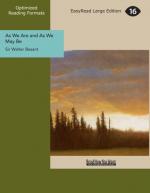In such journeyings and wanderings one must not go with an empty mind, otherwise there will be neither pleasure nor profit. The traveller, says Emerson, brings away from his travels precisely what he took there. Not his mind but his climate, says Horace, does he change who travels beyond the seas. In other words, if a man who knows nothing of archaeology goes to see a collection of flint implements, or a person ignorant of art goes to see a picture gallery, he comes away as ignorant as he went, because flint implements by themselves, or pictures by themselves, teach nothing. They can teach nothing. So, if a man who knows nothing of history should stand before Guildhall on the quietest Sunday in the whole year he will see nothing but a building, he will hear nothing but the fluttering wings of the pigeons. And if he wanders in the streets he will see nothing but tall and ugly houses, all with their blinds pulled down. Before he goes on a pilgrimage in the City he must first prepare his mind by reading history. This is not difficult to find. If he is in earnest he will get the great ‘Survey of London,’ by Strype and Stow, published in the year 1720 in two folio volumes. If this is too much for him, there are Peter Cunningham, Timbs, Thornbury, Walford, Hare, Loftie, and a dozen others, all of whom have a good deal to tell him, though there is little to tell, save a tale of destruction, after Strype and Stow.
Thus, before he begins he should learn something of Roman London, Saxon London, Norman London, of London medieval, London under the Tudors, London of the Stuarts, and London of the Georges. He should learn how the municipality arose, gaining one liberty after another, and letting go of none, but all the more jealously guarding each as a sacred inheritance; how the trade of the City grew more and more; how the Companies were formed, one after the other, for the protection of trade interests. Then he should learn how the Sovereign and great nobles have always kept themselves in close connection with the City, even in the proudest times of the Barons, even in the days when the nobles were supposed to have most despised the burgesses and the men of trade. He should learn, besides, how the City itself, its houses, and its streets, grew and covered up the space within the wall, and spread itself without; he should learn the meaning of the names—why one street is called College Hill and another Jewry and another Minories. Armed with such knowledge as this, every new ramble will bring home to him more and more vividly the history of the past. He will never be solitary, even at noon on Sunday morning even in Suffolk Street or Pudding Lane, because all the streets will be thronged with figures of the dead, silent ghosts haunting the scenes where they lived and loved and died, and felt the fierce joys of venture, of risk, and enterprise.
But let no man ramble aimlessly. It is pleasant, I own, to wander from street to street idly remembering what has happened here; but it is more profitable to map out a walk beforehand, to read up all that can be ascertained about it before sallying forth, and to carry a notebook to set down the things that may be observed or discovered.




